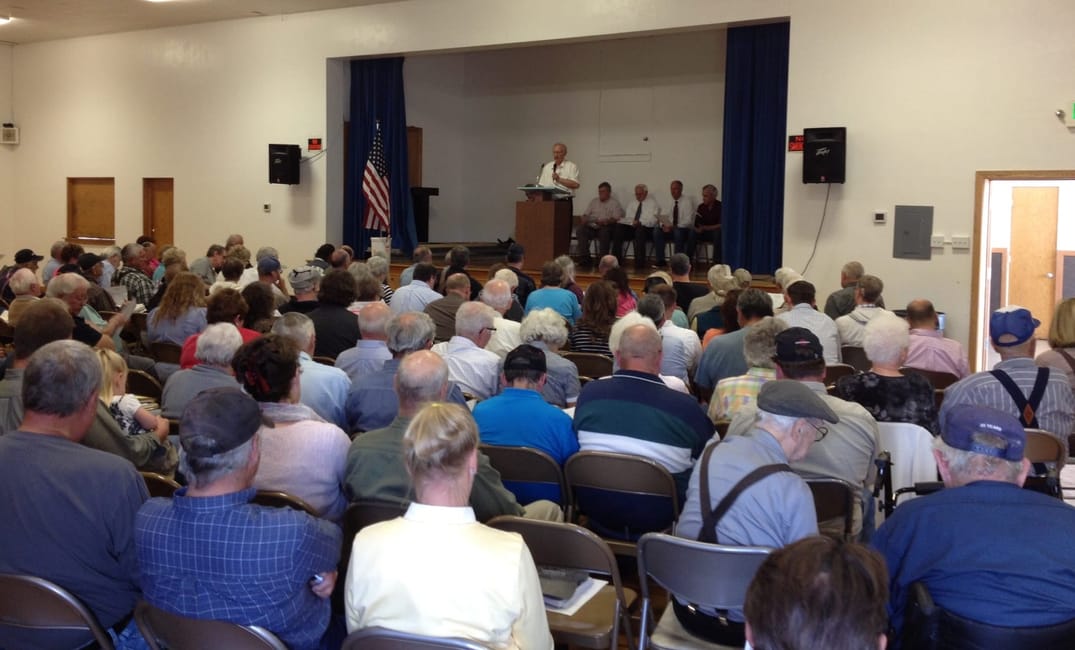By: Katie England
Daily Herald
Kevin Kraut stood outside the Veteran’s Memorial Building in Spanish Fork May 14, handing out pamphlets to the hundreds of people headed into the annual Relief Mine stakeholder meeting.
“DREAM MINE,” the pamphlet proclaimed in all-caps on a mustard-yellow cover. “A MONUMENT OF MYSTERY.”
Written by Kevin Kraut’s father, Ogden Kraut, the pamphlet details a version of the history of one of Utah County’s most intriguing stories: the inception of the Relief Mine, also known as the Dream Mine.
Visible today as a white processing mill standing out against the green of the surrounding vegetation in the foothills east of Salem, the mine is thought by most of its thousands of stakeholders to hold gold and/or treasures worth untold millions.
Though the mine hasn’t operated since 1949, stock is still bought and sold, and more than 7,000 people own shares.
But most stockholders are quick to tell you this isn’t a get-rich-quick scheme for them. The riches the mine is believed to hold will be available only at the end of days as prophesied in the Bible and the Book of Mormon.
History of the Relief Mine
John Koyle is at the epicenter of the Dream Mine’s story. He bought a farm in Salem in 1884, then 10 years later had a dream in which he was visited by what Kraut’s pamphlet describes as a heavenly messenger.
The messenger showed Koyle a rich Nephite gold mine, according to Kraut’s pamphlet, and instructed him to drill tunnels in the mountain to reach the gold.
Work at the mine began later that same year, and continued sporadically for years, until Koyle’s death in 1949.
During that time, no gold was produced from the mine — but supporters aren’t phased by the lack of profits.
Supporters put much faith in Koyle, who supposedly made other accurate predictions, from predicting the Great Depression to predicting the exact depth at which workers would strike water in the mine.
Bill Geertsen, of Kearns, said his father worked in the Relief Mine before Koyle’s death, and his grandfather had a “spiritual manifestation” that confirmed in his mind that what Koyle said about the mine was true.
The mine is for the purpose of helping others out and taking care of people who need it, Geertsen said.
“I think this is a bigger thing than any of us,” Geertsen said.
Complicated Relationship With LDS Church
Koyle was an active member of The Church of Jesus Christ of Latter-day Saints, though he was later excommunicated.
Even so, those who believe in the mine’s treasures are primarily of the Mormon faith, — including every member of the modern-day Relief Mine Co. board, according to board president Leroy Rose.
The beliefs of the Dream Mine and the LDS Church are closely intertwined, despite Koyle’s rocky past with the church.
The consensus is the treasures will not see the light of day until the end of times as prophesied in the Book of Mormon and the Bible.
“Christ never saw the triumph of His Church while He lived,” Ogden Kraut wrote in his self-printed book “Relief Mine.” “... and Bishop Koyle never realized the materialization of the ore deposited in that mountain. But in the last days they all shall see the fulfillment of their vision.”
Throughout the annual May stakeholder’s meeting, board members of the Relief Mine Co. insisted the purpose of the mine is to make sure there are resources to help those who need it when the end of times comes.
“The purpose of the relief mine is for when everything falls apart at the seams,” one board member said during the meeting. “The purpose is for individuals in the Relief Mine Co., to help not only themselves, but those who live in this area and are in dire need. That has always been the purpose of this work. It’s not for us to get rich and famous.”
Kraut agrees, saying that Koyle warned people not to hoard it, but to make sure they’re using it to help others at the appropriate time.
“I’m not going to leave you out high and dry because you don’t have stock,” Kraut said. Though he declined to say exactly how much stock is in his possession, Kraut said it was enough he could be on the Relief Mine Board if he wanted to.
But there are other, practical issues preventing the mine from being worked in modern times: the board isn’t sure it can afford to.
Rose said that right now, there’s no way to extract anything from the mine, as it would take a substantial amount of money to get everything legal and buy the necessary equipment.
There’s also a strong distrust of government, who Rose said would “be there in a heartbeat” to take things over once mining began.
The Utah Division of Oil, Gas and Mining has no records of the Relief Mine, as it was opened long before mining laws were enacted, according to spokeswoman Hollie Brown.
Modern Day Relief Mine Company
In modern times, the Relief Mine Company is made up of a board that oversees day-to-day operations, most of which have little to do with the mine itself.
The company gets its income from fruit sales from an orchard it runs, from a rental home and from a gravel pit, according to documents distributed at the annual stockholder’s meeting.
“The board, the only thing we are really doing right now, we have rental properties to keep up, and we have an orchard,” said Relief Mine Co. Board President Leroy Rose, who spoke briefly with the Daily Herald following the stockholder’s meeting in May. The board has an overall policy not to speak to media, Rose said.
The orchard is watered via pipes carrying water out of the mine, Rose said, and one of the biggest jobs is keeping the pipes functional as the minerals in the water frequently plug the pipes.
At the stakeholder’s meeting, the board reported more than 7,500 active stock holders. Over the course of the past year, 604 letters were sent to family members of stakeholders who died.
Provo residents Larry and Pat Ashby are among those who inherited their shares in the company when a relative died. Larry Ashby’s father regularly invested in “penny stocks” in the ’60s, and recently inherited 75 shares in the company.
The couple doesn’t remember Larry Ashby’s father talking about the shares before he died, and they are still learning about the Dream Mine, unsure what they believe about Koyle’s prophecies.
It seems a bit far-fetched, they said, to think there are treasures hidden away in the mine, though Larry Ashby said he believes there could be a large vein of gold to be mined out.
Either way, the Ashbys plan to keep their newly acquired shares.
“It’s kind of like, well, I have it. If something happens, great,” Larry Ashby said. “It’s almost like an antique. I don’t want to part with it because maybe it’s going to be valuable sometime.”
It’s hard to say exactly what the stock is worth, as there is no formal marketplace for exchanging shares. Those who want to buy or sell have to find someone willing to part with or buy shares. Following the stockholders meeting, those interested in buying or selling met up on one side of the room to do so.

